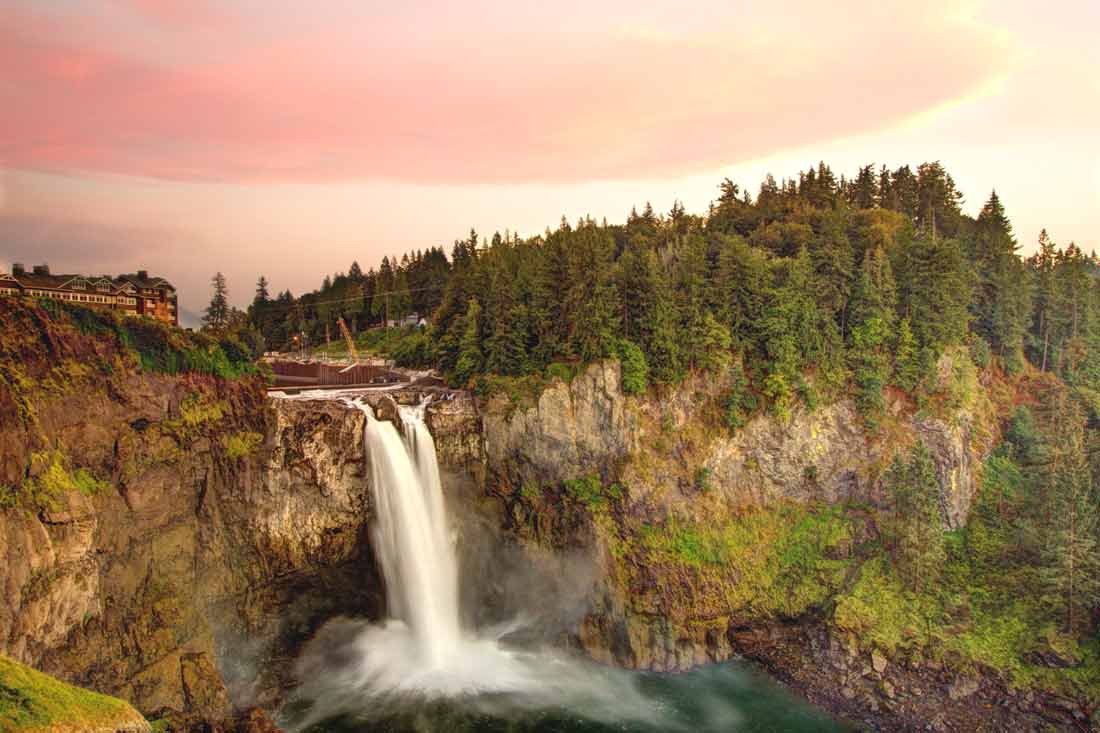Snoqualmie Falls – Winter | Weather | Facts | Travel Plan
Snoqualmie Falls is among the many largest and most important waterfalls within the United States. Situated alongside the Snoqualmie River within the city of Snoqualmie, the falls plunge a sheer 268 feet in an enormous amphitheater carved in historic volcanic bedrock.
Snoqualmie Falls facts
Total Height: 268 feet
Tallest Drop: 268 feet
Num of Drops: 1
Avg. Width: 100 feet
Pitch: 90 degrees
Run: 25 feet
Form: Plunge
Watershed: Snoqualmie River
Stream: Snoqualmie River
Avg. Volume: 285.0 cu ft/sec
Location: King County, Washington
Snoqualmie Falls Overview
The natural quantity of the Snoqualmie River, coupled with the great height of the falls makes it one of the highly effective waterfalls in North America.
However, that energy was too tempting a prospect for intrepid engineers, and in July of 1899 the Snoqualmie Falls Hydroelectric plant went on-line – the first hydroelectric facility on the earth to be constructed fully underground.
In 1910 a second powerhouse (this one above ground) was constructed downstream of the falls, which was drastically expanded once more within the late 1950s.
Because of the hydroelectric diversions, the Snoqualmie falls don’t frequently circulation with the drive of the complete quantity of the river.
However within the spring when the snow within the Cascade Mountains is melting at full bore, and within the early winter months when heavy rain frequents the Northwest, the river usually swells to spectacular proportions and it’s briefly restored to its natural splendor.
During such durations, spray from the falls swirls around within the amphitheater so fervently that it may well rise effectively above the top of the falls, and even be blinding at occasions (for visitors standing alongside the viewpoints that are).
In 2015 an enormous overhaul of the hydroelectric services on the falls was accomplished, which drastically elevated each facility output of the hydro stations, but additionally elevated the utmost capability of the diversion of the river as effectively.
The FERC license for the venture stipulated {that a} minimal launch of 100 cubic feet per second go over the falls throughout sunlight hours, at on sure holidays (Labor Day weekend, for instance) it increases to 200 CFS – that is truly a rise from the earlier minimal launch requirement.
The penstocks now have a complete capability of three,620 CFS, which is great sufficient that primarily the whole quantity of the river will probably be drawn off – save for the minimal required launch – for eight months out of the year, based mostly on the Daily Mean circulation statistics maintained by the USGS.
This can be drastically elevated from the earlier diversion capability. However, as a result of the Snoqualmie River does ceaselessly surpass this quantity within the Spring and early Winter months, it may well nonetheless be seen operating at impressively high ranges.
Because it is located so near the Puget Sound metropolitan space, Snoqualmie Falls is among the many hottest vacationer locations within the state of Washington; receiving a median of over 1.5 million visitors every year.
This has definitely been bolstered by the falls’ look within the opening credit of the present Twin Peaks, which aired from 1990-1991 – a lot of the present was filmed in Roselyn, Washington, however many exterior and environmental pictures have been filmed around Snoqualmie and North Bend.
Snoqualmie falls History and Naming
Snoqualmie Falls is the Official name of this waterfall.
Snoqualmie is the English translation and spelling of the Salish “sah-KOH-koh” or “Sdob-dwahibbluh”, which means Moon. The falls have been first seen by non-native Washington Hall in 1848 and have become a well-known vacationer vacation spot by 1865.
The hydroelectric facility was put in beneath the falls in 1899 and continues operation at the moment, and the Snoqualmie Falls Lodge (now the Salish Lodge) was opened in 1919 after the Sunset Highway was constructed.
Other Recommended Reading
- Egg Island Description | Facts | Travel | History
- Antelope Island – State Park | Hikes | Camping | Directions
- Wizard Island Facts | Crater Lake | Volcano | Boat Tour
- Cascade Range Oregon | Volcanoes | Mountain | Facts
- Mount Rainier National Park | Weather | Eruption
- Christine Falls Facts | Bridge | Description | Travel
- Treasury Petra Jordan – Inside | Facts | History | Architecture
- June Lake California – Facts | Weather | Camping | Fishing
- Timberline Lodge – Oregon | Colorado | Weather | History
- Latourell Falls Hikes | Directions | Loop Trail | Open
- Toketee Falls – Hike | Trailhead | Directions | Weather
- 81 Mount St Helens Facts that Surprise Anyone
- Mount Mazama eruption – Date | Volume | History
- Bridal Veil Falls Trail – Information | Facts | Guideline
- Bridal Veil Falls Hike Information and Guide
- Death Valley National Park Facts | Travel | Map
- Emerald Pools Trail Travel Facts and Guideline
- Rainbow Bridge Niagara Falls NY – Facts | Travels
- Niagara Falls NY Boat Tour Best Short Tips
- Wax Museum Niagara Falls NY Tourist Guide
Location & Directions
Coordinates: 47.54174, -121.83808
Elevation: 395 feet
USGS Map: Snoqualmie 7 1\/2″
Snoqualmie Falls is positioned instantly west of the city of Snoqualmie alongside the Interstate 90 hall. Exit Interstate 90 on the Snoqualmie Parkway exit, turning north (uphill) and proceed roughly four miles to Highway 202, then head left to the falls in one other half mile.
Accessible trails lead from the spacious parking areas on both aspects of the freeway to in-depth viewpoints alongside the gorge rim. Additionally, a path to the bottom of the Snoqualmie falls results in a newly constructed boardwalk that overlooks the falls from the bottom. Learn more about unique-things-to-do-in-Palm-Springs.

